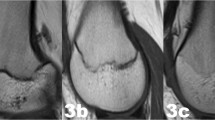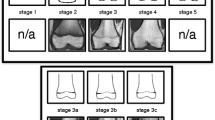Abstract
Objectives
To assess the performance of knee MRI for forensic age prediction and classification for 12-, 14-, 16-, and 18-year thresholds.
Methods
The ossification stages of distal femoral epiphyses and proximal tibial epiphyses were assessed using an integrated staging system by Schmeling et al. and Kellinghaus et al. for knee 3.0T MRI with T1-weighted turbo spin-echo (T1-TSE) in sagittal orientation among 852 Chinese Han individuals (483 males and 369 females) aged 7–30 years. Regression models for age prediction were constructed and their performances were evaluated based on mean absolute deviation (MAD) values. In addition, the performances of age classification were assessed using receiver operating characteristic (ROC) analyses.
Results
The intra- and inter-observer agreement levels were very good (κ > 0.80). The complete fusion of those two types of epiphyses took place before 18.0 years in our study participants. The minimum MAD values were 2.51 years (distal femur) and 2.69 years (proximal tibia) in males, and 2.75 years (distal femur) and 2.87 years (proximal tibia) in females. The specificity values of constructed prediction models were all above 90% for the 12-, 14-, and 16-year thresholds, compared to the 74.8–84.6% for the 18-year threshold. Better performances of age prediction and classification were observed in males by distal femoral epiphyses.
Conclusions
Ossification stages via 3.0T MRI of the knee with T1-TSE sequence using an integrated staging system could be a reliable noninvasive method for age prediction or for age classification for 12-, 14-, and 16-year thresholds, especially in males by distal femoral epiphyses. However, assessments based on the full bony fusion of the distal femoral epiphysis and proximal tibial epiphysis seemed not reliable for age classification for the 18-year threshold in the Chinese Han population.



Similar content being viewed by others
References
Sykes L, Bhayat A, Bernitz H (2017) The effects of the refugee crisis on age estimation analysis over the past 10 years: a 16-country survey. Int J Environ Res Public Health 14(6):630–638. https://doi.org/10.3390/ijerph14060630
Sironi E, Gittelson S, Bozza S, Taroni F (2021) Minor or adult? Introducing decision analysis in forensic age estimation. Sci Justice 61(1):47–60. https://doi.org/10.1016/j.scijus.2020.09.004
Black S, Aggrawal A, Payne-James J (2010) Age estimation in the living: the practitioner’s guide. Wiley-Blackwell, Chichester
Schmeling A, Grundmann C, Fuhrmann A, Kaatsch HJ, Knell B, Ramsthaler F, Reisinger W, Riepert T, Ritz-Timme S, Rosing FW, Rotzscher K, Geserick G (2008) Criteria for age estimation in living individuals. Int J Legal Med 122(6):457–460. https://doi.org/10.1007/s00414-008-0254-2
Schulz R, Muhler M, Reisinger W, Schmidt S, Schmeling A (2008) Radiographic staging of ossification of the medial clavicular epiphysis. Int J Legal Med 122(1):55–58. https://doi.org/10.1007/s00414-007-0210-6
Berlin L (2014) Shared decision-making: is it time to obtain informed consent before radiologic examinations utilizing ionizing radiation? Legal and ethical implications. J Am Coll Radiol 11(3):246–251. https://doi.org/10.1016/j.jacr.2013.10.006
Nievelstein RA, Frush DP (2012) Should we obtain informed consent for examinations that expose patients to radiation? AJR Am J Roentgenol 199(3):664–669. https://doi.org/10.2214/AJR.11.8319
Ritz-Timme S, Cattaneo C, Collins MJ, Waite ER, Schutz HW, Kaatsch HJ, Borrman HI (2000) Age estimation: the state of the art in relation to the specific demands of forensic practise. Int J Legal Med 113(3):129–136. https://doi.org/10.1007/s004140050283
Vucic S, de Vries E, Eilers PH, Willemsen SP, Kuijpers MA, Prahl-Andersen B, Jaddoe VW, Hofman A, Wolvius EB, Ongkosuwito EM (2014) Secular trend of dental development in Dutch children. Am J Phys Anthropol 155(1):91–98. https://doi.org/10.1002/ajpa.22556
Mora S, Boechat MI, Pietka E, Huang HK, Gilsanz V (2001) Skeletal age determinations in children of European and African descent: applicability of the Greulich and Pyle standards. Pediatr Res 50(5):624–628. https://doi.org/10.1203/00006450-200111000-00015
De Tobel J, Bauwens J, Parmentier GIL, Franco A, Pauwels NS, Verstraete KL, Thevissen PW (2020) Magnetic resonance imaging for forensic age estimation in living children and young adults: a systematic review. Pediatr Radiol 50(12):1691–1708. https://doi.org/10.1007/s00247-020-04709-x
Ekizoglu O, Er A, Bozdag M, Basa CD, Kacmaz IE, Moghaddam N, Grabherr S (2021) Forensic age estimation via magnetic resonance imaging of knee in the Turkish population: use of T1-TSE sequence. Int J Legal Med 135(2):631–637. https://doi.org/10.1007/s00414-020-02402-0
Uygun B, Kaya K, Kose S, Ekizoglu O, Hilal A (2021) Applicability of magnetic resonance imaging of the knee in forensic age estimation. Am J Forensic Med Pathol 42(2):147–154. https://doi.org/10.1097/PAF.0000000000000634
Daghighi MH, Pourisa M, Javanpour-Heravi H, Ghojazadeh M, Mirza-Aghazadeh-Attari M, Daghighi S, Jabbari KH, Zarrintan A (2021) Application of knee MRI in forensic age estimation: a retrospective cohort. Radiography (Lond) 27(1):108–114. https://doi.org/10.1016/j.radi.2020.06.019
Auf Der Mauer M, Säring D, Stanczus B, Herrmann J, Groth M, Jopp-van Well E (2019) A 2-year follow-up MRI study for the evaluation of an age estimation method based on knee bone development. Int J Legal Med 133(1):205–215. https://doi.org/10.1007/s00414-018-1826-4
El-Din EAA, Mostafa HES, Tantawy EF, El-Shafei DA (2019) Magnetic resonance imaging of the proximal tibial epiphysis: could it be helpful in forensic age estimation? Forensic Sci Med Pathol 15(3):352–361. https://doi.org/10.1007/s12024-019-00116-3
Vieth V, Schulz R, Heindel W, Pfeiffer H, Buerke B, Schmeling A, Ottow C (2018) Forensic age assessment by 3.0T MRI of the knee: proposal of a new MRI classification of ossification stages. Eur Radiol 28(8):3255–3262. https://doi.org/10.1007/s00330-017-5281-2
Ottow C, Schulz R, Pfeiffer H, Heindel W, Schmeling A, Vieth V (2017) Forensic age estimation by magnetic resonance imaging of the knee: the definite relevance in bony fusion of the distal femoral- and the proximal tibial epiphyses using closest-to-bone T1 TSE sequence. Eur Radiol 27(12):5041–5048. https://doi.org/10.1007/s00330-017-4880-2
Ekizoglu O, Hocaoglu E, Inci E, Can IO, Aksoy S, Kazimoglu C (2016) Forensic age estimation via 3-T magnetic resonance imaging of ossification of the proximal tibial and distal femoral epiphyses: Use of a T2-weighted fast spin-echo technique. Forensic Sci Int 260:101–102. https://doi.org/10.1016/j.forsciint.2015.12.006
Fan F, Zhang K, Peng Z, Cui J, Hu N, Deng Z (2016) Forensic age estimation of living persons from the knee: comparison of MRI with radiographs. Forensic Sci Int 268:145–150. https://doi.org/10.1016/j.forsciint.2016.10.002
Saint-Martin P, Rérolle C, Pucheux J, Dedouit F, Telmon N (2015) Contribution of distal femur MRI to the determination of the 18-year limit in forensic age estimation. Int J Legal Med 129(3):619–620. https://doi.org/10.1007/s00414-014-1020-2
Krämer JA, Schmidt S, Jürgens K, Lentschig M, Schmeling A, Vieth V (2014) Forensic age estimation in living individuals using 3.0T MRI of the distal femur. Int J Legal Med 128(3):509–514. https://doi.org/10.1007/s00414-014-0967-3
Krämer JA, Schmidt S, Jürgens K, Lentschig M, Schmeling A, Vieth V (2014) The use of magnetic resonance imaging to examine ossification of the proximal tibial epiphysis for forensic age estimation in living individuals. Forensic Sci Med Pathol 10(3):306–313. https://doi.org/10.1007/s12024-014-9559-2
Dedouit F, Auriol J, Rousseau H, Rougé D, Crubézy E, Telmon N (2012) Age assessment by magnetic resonance imaging of the knee: a preliminary study. Forensic Sci Int 217(1-3):231–232. https://doi.org/10.1016/j.forsciint.2011.11.013
Wittschieber D, Chitavishvili N, Papageorgiou I, Malich A, Mall G, Mentzel H (2021) Magnetic resonance imaging of the proximal tibial epiphysis is suitable for statements as to the question of majority: a validation study in forensic age diagnostics. Int J Legal Med. https://doi.org/10.1007/s00414-021-02766-x
Alatas O, Altınsoy HB, Gurses MS, Balci A (2021) Evaluation of knee ossification on 1.5 T magnetic resonance images using the method of Vieth et al. Rechtsmedizin 31(1):50–58. https://doi.org/10.1007/s00194-020-00432-x
Schmeling A, Schulz R, Reisinger W, Hler M, Wernecke K, Geserick G (2004) Studies on the time frame for ossification of the medial clavicular epiphyseal cartilage in conventional radiography. Int J Legal Med 118(1):5–8. https://doi.org/10.1007/s00414-003-0404-5
Kellinghaus M, Schulz R, Vieth V, Schmidt S, Pfeiffer H, Schmeling A (2010) Enhanced possibilities to make statements on the ossification status of the medial clavicular epiphysis using an amplified staging scheme in evaluating thin-slice CT scans. Int J Legal Med 124(4):321–325. https://doi.org/10.1007/s00414-010-0448-2
Jopp E, Schröder I, Maas R, Adam G, Püschel K (2010) Proximale Tibiaepiphyse im Magnetresonanztomogramm. Rechtsmedizin 20(6):464–468. https://doi.org/10.1007/s00194-010-0705-1
Lu T, Qiu L, Ren B, Shi L, Fan F, Deng Z (2021) Forensic age estimation based on magnetic resonance imaging of the proximal humeral epiphysis in Chinese living individuals. Int J Legal Med 135(6):2437–2446. https://doi.org/10.1007/s00414-021-02653-5
Lu T, Shi L, Zhan MJ, Fan F, Peng Z, Zhang K, Deng ZH (2020) Age estimation based on magnetic resonance imaging of the ankle joint in a modern Chinese Han population. Int J Legal Med 134(5):1843–1852. https://doi.org/10.1007/s00414-020-02364-3
Martinez VN, Holler J, Widek T, Neumayer B, Ehammer T, Urschler M (2017) Forensic age estimation by morphometric analysis of the manubrium from 3D MR images. Forensic Sci Int 277:21–29. https://doi.org/10.1016/j.forsciint.2017.05.005
Mauer MAD, Well EJ, Herrmann J, Groth M, Morlock MM, Maas R, Säring D (2021) Automated age estimation of young individuals based on 3D knee MRI using deep learning. Int J Legal Med 135(2):649–663. https://doi.org/10.1007/s00414-020-02465-z
Pröve P, Jopp-van Well E, Stanczus B, Morlock MM, Herrmann J, Groth M, Säring D, Auf Der Mauer M (2019) Automated segmentation of the knee for age assessment in 3D MR images using convolutional neural networks. Int J Legal Med 133(4):1191–1205. https://doi.org/10.1007/s00414-018-1953-y
Dallora AL, Berglund JS, Brogren M, Kvist O, Diaz RS, Dubbel A, Anderberg P (2019) Age assessment of youth and young adults using magnetic resonance imaging of the knee: a deep learning approach. JMIR Med Inform 7(4):e16291. https://doi.org/10.2196/16291
Ducharme JR, Collu R (1982) Pubertal development: normal, precocious and delayed. Clin Endocrinol Metab 11(1):57–87. https://doi.org/10.1016/s0300-595x(82)80038-8
Wittschieber D, Schulz R, Vieth V, Küppers M, Bajanowski T, Ramsthaler F, Püschel K, Pfeiffer H, Schmidt S, Schmeling A (2014) Influence of the examiner’s qualification and sources of error during stage determination of the medial clavicular epiphysis by means of computed tomography. Int J Legal Med 128(1):183–191. https://doi.org/10.1007/s00414-013-0932-6
Funding
This project was supported by the Key Research and Development Program of Sichuan Province of China (Grant Number: 22ZDYF1829), the Postdoctoral Research Project of Sichuan Province (Grant Number: 2021-12), the Opening Project of Key Laboratory of Evidence Science (China University of Political Science and Law), Ministry of Education (Grant Number: 2021KFKT03), National Natural Science Foundation of China (Grant Number: 81971801, 81373252) and the Cooperation Project between North Sichuan Medical College and Local Government (Grant Number: 18SXHZ0172).
Author information
Authors and Affiliations
Corresponding authors
Ethics declarations
Research involving human participants and/or animals
This article does not contain any studies with animals performed by any of the authors.
Ethical approval/Informed consent
All procedures performed in the study were in accordance with the ethical standards of the institutional research committee.
Conflict of Interest
The authors declare no competing interests.
Additional information
Publisher’s note
Springer Nature remains neutral with regard to jurisdictional claims in published maps and institutional affiliations.
Supplementary Information
Supplementary Table 1
(DOCX 17 kb)

Supplementary Fig. 1
Eleven regression models of ossification stage scores of distal femoral epiphysis and proximal tibial epiphysis for chronological age based on the training set in males and females, respectively. (PNG 564 kb)
Rights and permissions
About this article
Cite this article
Deng, XD., Lu, T., Liu, GF. et al. Forensic age prediction and age classification for critical age thresholds via 3.0T magnetic resonance imaging of the knee in the Chinese Han population. Int J Legal Med 136, 841–852 (2022). https://doi.org/10.1007/s00414-022-02797-y
Received:
Accepted:
Published:
Issue Date:
DOI: https://doi.org/10.1007/s00414-022-02797-y




